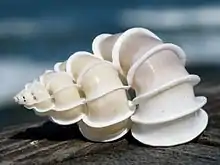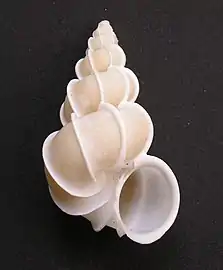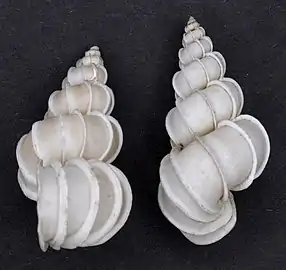Epitonium scalare
Epitonium scalare, common name the precious wentletrap, is a predatory or ectoparasitic species of marine gastropod with an operculum, in the family Epitoniidae, the wentletraps.[1]
| Epitonium scalare | |
|---|---|
 | |
| A shell of Epitonium scalare | |
| Scientific classification | |
| Kingdom: | |
| Phylum: | |
| Class: | |
| (unranked): | |
| Superfamily: | |
| Family: | |
| Genus: | |
| Species: | E. scalare |
| Binomial name | |
| Epitonium scalare | |
| Synonyms[1] | |
| |
In the 17th and 18th century this was once considered to be a very rare shell and specimens changed hands for large sums of money. Johan de la Faille and Cosimo III de' Medici owned a wentletrap.
Distribution
This species is distributed in the Red Sea, in the Indian Ocean along Madagascar and South Africa, in the South West Pacific Ocean and along Fiji Islands and Japan.
Shell description
Adult shells of this species attain a length of between 25 mm to 72 mm.[2]
Many Epitonium species have shells that are very attractive and quite interesting in their structure. However this species is particularly striking, partly because it is very large compared with the great majority of other species within the genus, but also because the whorls themselves do not touch and so the shell is held together only by the well-developed ribs or costae.
The shell of Epitonium scalare has sculpture consisting of raised ribs that are known as costae. Costae are a very common feature in shells of many Epitonium species.
References
- Rosenberg, G. (2010). Epitonium scalare (Linnaeus, 1758). In: Bouchet, P.; Gofas, S.; Rosenberg, G. (2010) World Marine Mollusca database. Accessed through: World Register of Marine Species at http://www.marinespecies.org/aphia.php?p=taxdetails&id=207942 on 2010-11-22
- "Epitonium scalare (Linnaeus, 1758) The Precious Wentletrap". Jacksonville Shell Club, accessed 12 March 2010.
Further reading
Dance, S. Peter, 1969, Rare Shells, University of California Press.128 p, 24 color plates, ISBN 9780571082179
External links
- "Epitonium (Eburniscala) scalare scalare". Gastropods.com. Retrieved 22 November 2010.
| Wikimedia Commons has media related to Epitonium scalare. |


